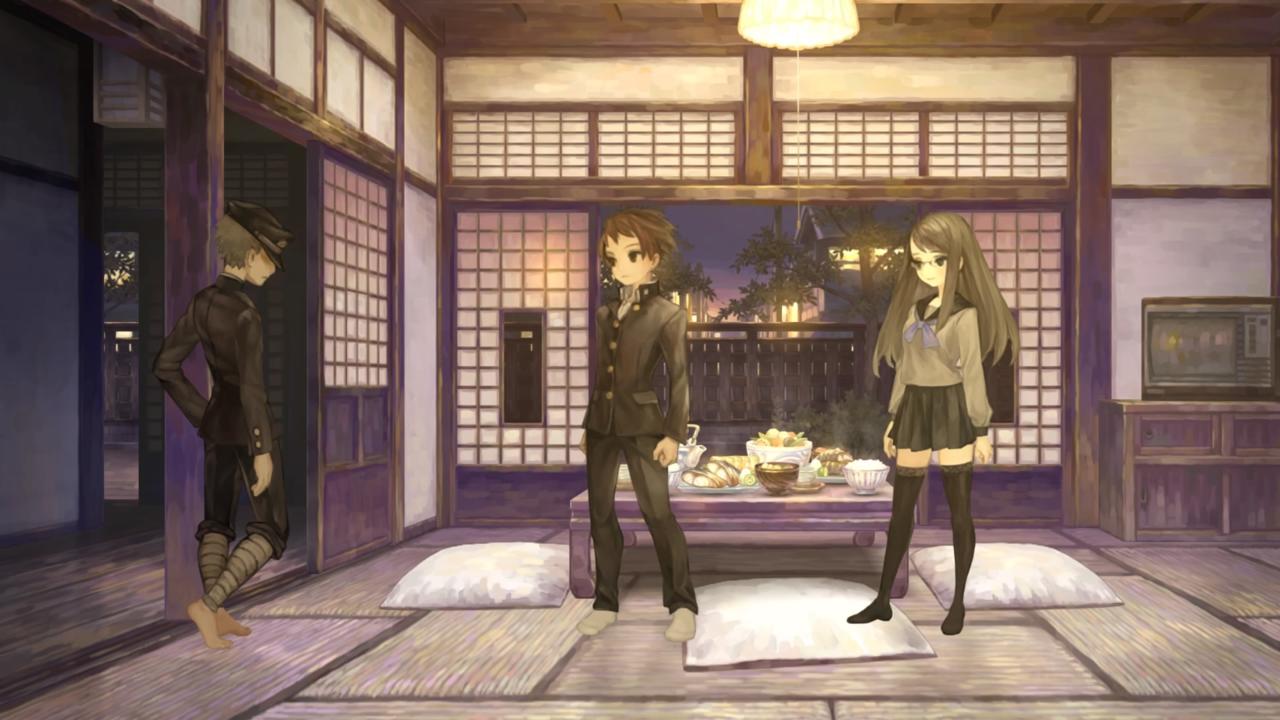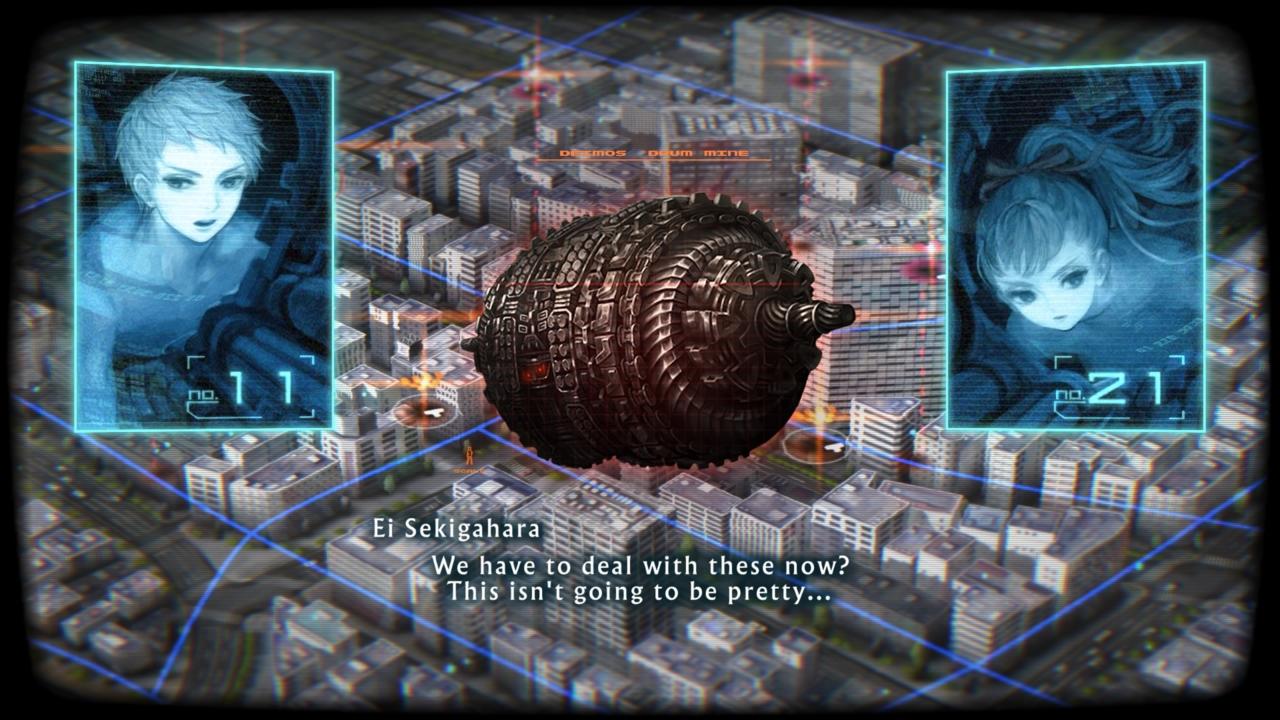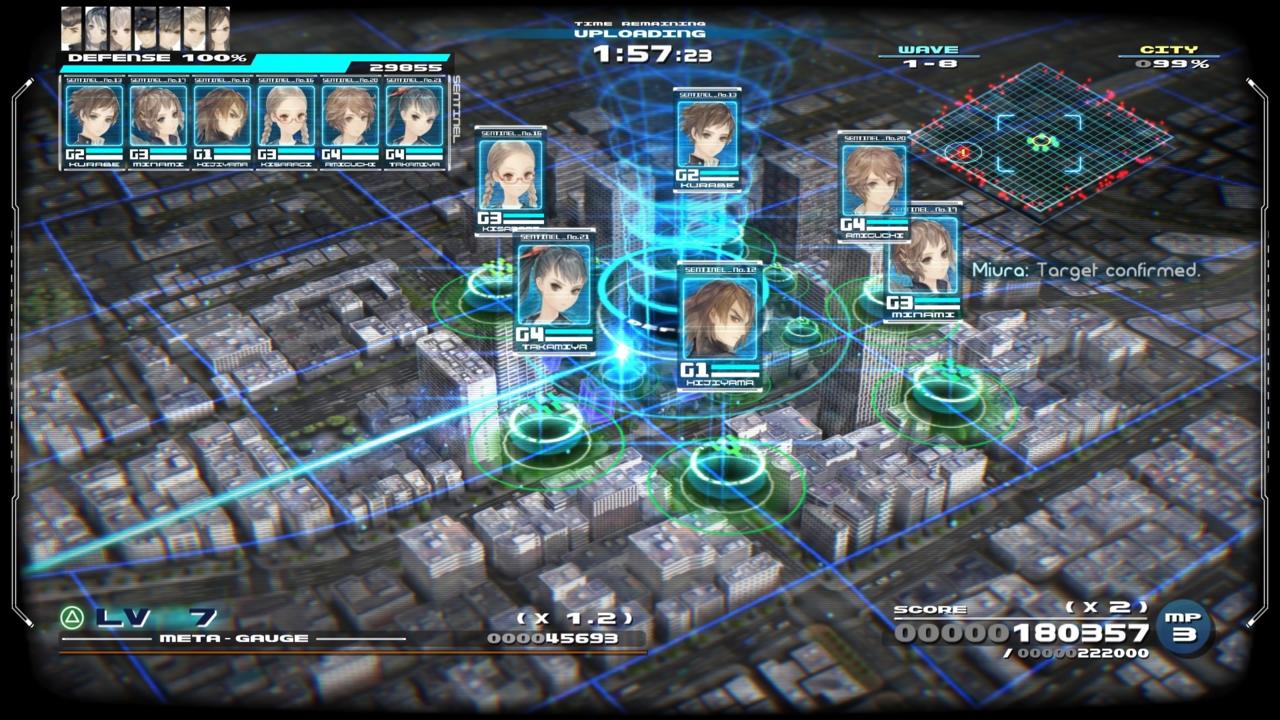Despite what the box and blurbs might tell you, 13 Sentinels: Aegis Rim isn't really a game about piloting giant robots. I mean, sure, you do fight off massive swarms of building-sized creatures hellbent on total destruction in an alternate-universe 1980s Japan at some points. But these seemingly model-kit-ready metal combat suits are just a plot device, a cog in the story. In actuality, 13 Sentinels: Aegis Rim is a character drama: a twisting, turning sci-fi epic jumping through time and dimensions as it follows the lives of its numerous teen protagonists. Missiles, Gatling guns, and armor-crushing metal fistcuffs are merely a side event to the everyday drama of highschoolers who find themselves unwilling pawns in a bigger game with the fate of the world at stake. And you know what? That's great. Once the narrative of 13 Sentinels sinks its hooks into you, you want nothing more than to go along for the ride up until the very climax.
13 Sentinels is a unique, genre-mixing experiment. It takes elements of point-and-click adventure games, visual novels, real-time strategy games, and tower defense games, mixing them together to create an experience that's quite unlike anything else out there. Things get rolling when young Japanese highschooler Juro Kurabe is called upon to fight a horde of alien invaders in 1985, only for the story to flash back to earlier that year, then over to young soldiers in 1945 wartime-era Japan, then to two schoolgirls witnessing a crisis in the year 2025. You immediately meet a huge cast of characters across different eras, learning that there is one constant: the existence of Sentinels, massive human-piloted robot weapons who exist to protect the world from otherworldly monsters.

The game is split into three parts: a Remembrance mode where you uncover the story piece by piece, a Destruction mode where you use giant Sentinel mechs to protect the city from invasion, and an Analysis mode that collects all of the information and story scenes you have discovered through gameplay. Remembrance is presented as an episodic series where you explore and interact with various environments and characters to advance the plot. Destruction, in contrast, is an overhead-view strategy segment where you use the Sentinels to defend a critical underground access point from invading forces.
The narrative sequences of Remembrance take up the good majority of the game's playtime. Each of the 13 main characters' individual adventures occurs at a different time and place, but every story eventually intertwines, with some crucial events playing out through the perspectives of several cast members. Gameplay is fairly basic: You can walk around to talk to other characters, stand around to observe the environment, and examine particular objects in an area. Occasionally, key words will be added to a character's "thought cloud," which acts like an item inventory; you can ruminate on the topics via an inner monologue, bring up thought cloud topics to others, or utilize physical items. Progress happens when you hit on the right dialogue or action.
You only control one character at a time, but you can swap between characters' stories as you see fit--though you may find yourself locked out of a character's path until you have made significant progress in others' storylines and the mech battles. The nonlinear, non-chronological storytelling presents you with many mysteries and questions which you must piece together to get a bigger picture of what is actually going on--and how to save everything from absolute ruin.
13 Sentinels does a great job telling an engaging story from several perspectives; not only does everything fit together, but the characters have distinct, well-defined backgrounds and personalities to avoid confusing the audience. Each of these 13 characters’ individual adventures is a treat to unravel as more and more important events, revelations, and romantic entanglements come to light.
There's Juro, a nerd who loves obscure sci-fi B-movies and hanging out with his best friend after school. He shares a class with Iori, a somewhat clumsy girl who keeps falling asleep during school because terrifying dreams keep her up at night. Meanwhile, resident UFO and conspiracy nut Natsuno may have just found the secret of a time-travelling alien civilization in the girls' locker room. She just met Keitaro, a guy who seems to have been spirited here from wartime Japan, and who also might have a thing for her. Shu is a spoiled kid with a thing for the school's resident tough girl, Yuki, who is too busy investigating mysteries around school to care for his advances. But why is Ryoko bandaged up, constantly monitored, and gradually losing her sanity? And why is Megumi hearing a talking cat ordering her to attack her classmates?

That's just a sampling of the many character mini-dramas you see throughout the game, as the ordinary lives of these kids get flipped upside down and a massive, reality-changing mystery unfolds. Ultimately, however, the story works because the individual character drama is so well done, with each character's tale playing a key role in the bigger, overarching sci-fi plot.
It also helps that the story sequences in 13 Sentinels are fantastic to look at. Developer Vanillaware is known for its vibrant, colorful 2D artwork in games like Odin Sphere and Dragon's Crown. While 13 Sentinels takes place primarily in a more "real-world" setting than those fantasy-based games, the beauty of Vanillaware's 2D artwork is still on full display. The environments are filled with little details that really make them come alive, from the reveling drunken bench-squatters by the train station entrance to the crumbling, shaking foundations of ruined buildings in the apocalyptic futures barely standing among the husks of dead invaders. Character animation is also excellent, with many characters featuring fun little facial and body movement quirks that bring out elements of their personalities.

Perhaps the biggest problem with the story segments, however, is that they are notably more enjoyable than the real-time strategy portion, where the gigantic Sentinels are supposed to really shine. The Destruction portion of the game is a mix of quasi-RTS and tower-defense mechanics: You command up to six individual Sentinel units in a usually-timed battle to protect a defensive node from a lengthy enemy onslaught. Each unit has a specialized role (such as melee, support, flying, etc.) and offensive and defensive skills, which can be individually upgraded to your liking through "meta-chips" earned in battle and from completing story episodes. If you either wipe out all of the enemies or manage to hold the fort for a specific amount of time, you win.
These battles certainly have their moments. It's immensely satisfying to plan out a strategy and watch it play out--or to decide to go HAM with your best weapon and watch a couple dozen enemy drones explode simultaneously in a flurry of fireworks (which are enough to make a standard PS4 model slow down). Eventually, however, the game stops introducing new and interesting threats, making these strategy bits feel less exciting as you progress. The gorgeous 2D visuals and animation are also replaced with a bland, blocky 3D map that isn't anywhere near as pleasant to look at for long stretches of time. While there's a good amount of inter-character bantering and key story revelations before and after these combat sequences, you can't help but feel like they can often be a roadblock to enjoying the more interesting story parts of the game--especially since clearing certain enemy waves in Destruction is necessary to open parts of the story in Remembrance.
For Switch players 13 Sentinels: Aegis Rim has made the transition to Nintendo's semi-portable platform with very few compromises. Everything from the PlayStation 4 original is here and looking great: the 2D adventure scenes and cinematics are as gorgeous as ever and, for the most part, the 3D strategy sections only suffer a minor hit to visuals and performance when compared to the original. There is a slight amount of slowdown during 2D sections where a lot is happening on screen, though you likely won't even notice the difference unless you've played the PS4 version extensively. New to the Switch version are some additional weapon options for each of the robotic Sentinel units: they're nice additions, but hardly game-changing given the original weapon spread was more than sufficient to complete the game with. Overall, this is a superb port worth picking up if you have yet to play this amazing title–or if you want to experience the enthralling saga all over again.
Ultimately, the biggest problem with 13 Sentinels is that a chunk of the game is merely good while the majority of it is outstanding. The stories of these kids and their giant robots absolutely consumed me during my playtime, and even now, I'm ruminating over certain plot points, events, and relationships, wondering if I should go back through the archives to see what I've missed. I don't think I'll forget my time in the 13 Sentinels world, and I doubt you will, either.









